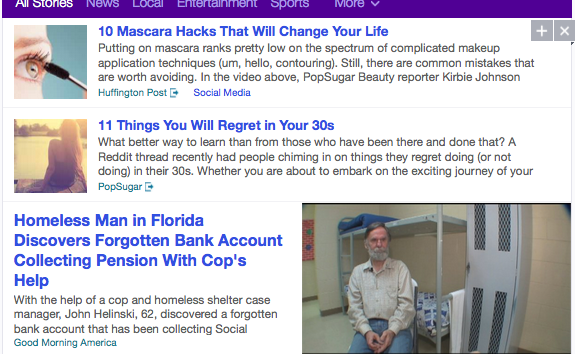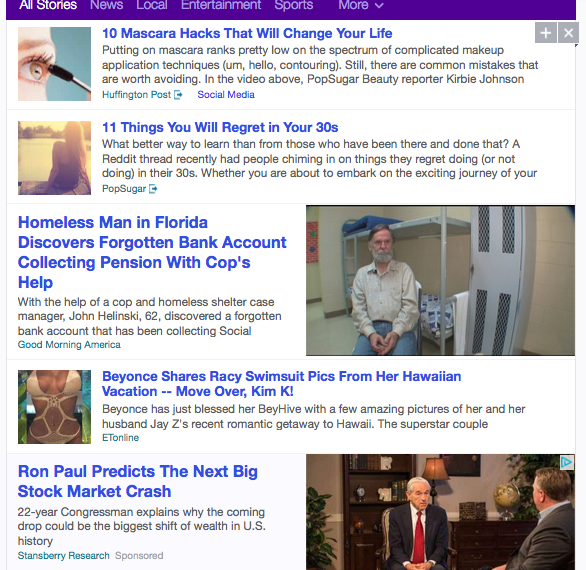
by author Jodi Stout
Which one is the paid-for “news article?”
A major controversy is brewing between traditional journalists and new media marketers over “brand journalism” or “native advertising.” The lines are becoming increasingly blurred between news and advertising across every medium and consumers are left wondering what to expect from their once trusted news sources.
One of Yahoo’s top news stories today is headlined to gain attention regarding the “viral phenomenon” of this campaign. Yet the “news article” simply advertises a network tv show in an overtly journalistic style. Clickbait much?
Physically, news and advertisements are becoming virtually indistinguishable. This screenshot of Yahoo’s home page shows several different presentation formats that all look like real news stories. Can an “average” consumer reasonably be expected to quickly distinguish which articles are paid advertising or what is fake news?
This practice of hiding the intention of a “news article” has recently become even more calculated. Until not long ago, consumers could safely expect ads to be noted. Magazines clearly marked “advertisement” across the spreads that resemble an actual article.
Notice of paid, or sponsored, content is now being reduced to a minuscule icon that is barely visible. Do you see the tiny blue arrow camouflaged in the top right of the video thumbnail and the “sponsored” in ghost-like gray?
How is the common denominator of internet user going to be able to avoid being tricked into being “sold to” when overzealous content controllers stoop to intentionally deceptive practices for their own statistical goals?
Trusted journalistic sources cannot lose sight of their moral compass, especially online. The entire spectrum of publishing by a corporation is expected to adhere to the code of journalism ethics and not resort to bribery and trickery for readership or click-throughs.
On the flip side, it’s no secret that print newspapers across the country are crumbling under competition from new media outlets and their online versions have yet to produce a business model that’s as profitable as the printed versions once were.
Consumers aren’t proven willing to pay for news and stories from online sources and old media are struggling with how to adapt in today’s rapidly evolving environment of instantaneous production, distribution and consumption of digital content.
Traditional media giants are continuing to explore ways to subsidize their products. The New York Times is offering digital subscriptions for as low as 99 cents per week. There are banner and sidebar ads on each page. But is this enough to keep a corporate behemoth successfully operating long-term?
Apparently not. The once-revered NYT is now promoting corporate sponsorship of articles under the guise of real news. According to Last Week Tonight’s John Oliver, Chevron recently sponsored an eco-article that noticeably didn’t mention oil drilling as being an environmental issue. This kind of tactic erodes consumer confidence in media as this news story appears blatantly influenced by it’s “sponsor.”
“In much of what they do, media companies are by no means independent of commercial interests. Many stories that purport to be unbiased are the product of public relations companies or other organizations. As one small example, most newspapers are happy to build their travel journalism on a system in which companies give them freebies in return for favorable write-ups.” (Brand Journalism)
Trusted entities like NPR and PBS are funded by corporate sponsorships and viewer support while innovative companies like Media Storm have found success in licensing out their stories. Publisher-producer Vice Magazine targets relevant-to-the-story backers like North Face to underwrite their documentaries.
Viewers can be reasonably expected to understand the need for and placement of a corporate sponsor in these cases, they just don’t expect to have their news stories slanted because of advertisers.
There’s a myriad of potential answers to the woes of traditional publishing but many media moguls appear to be heavily leaning toward ”brand journalism” or “native advertising” to support both the objective and the business of news.
As standards are quickly evolving in this gold rush of content consumption, the ethics of news and story production can suffer under the pressure of the public’s expectation of immediate response and the cost of producing it. They have to find sources to underwrite more extensive production.
“The mission of journalism is to inform, and that requires observation, selection and interpretation, with all the biases that entails. The business of journalism is to provide marketing partners with new ways to reach consumers (DVorkin).”
The conflict between old school journalists and new media marketers revolves primarily around the two critical components: funding and ethics. Though they thrive symbiotically and each cannot exist without the other, mixing them together can lead to devastating consequences.
I expect the debate over brand journalism will continue to weigh heavily in media discussion groups for some time to come. However, there is no doubt that the “advertorial” is here to stay. The question remains if journalists can stay true to their oaths made according to the Society of Professional Journalists.
Now for a very funny look at Native Advertising on:
Native Advertising on Last Week Tonight with John Oliver
What is your opinion of Native Advertising?


